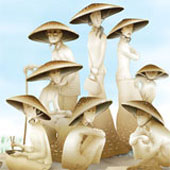This is an exercise in exploring Visual Transformations - how one can transform one visual to create another.

There are three ways to do this - by Substitution, by Insertion and by Omission (also known as semiotic operators). This means that we can substitute features from something else, insert a new feature or omit an existing feature in order to create a new visual image. And this seems to be the way a visual designer creates new visual images, signs and representations.



Let's say you are designing an identity sign for an organisation, you would start by understanding the characteristics of the organisation and then try to create a visual sign that integrates these features or characteristics. Your aim is to end up with a visual sign that expresses what the organisation stands for.

In doing such exercises, we can also look at nature for inspiration. In fact, mankind since the beginning of time has looked at nature for inspiration, adopted these ideas and created many applications in the fields of art, design, sciences and technology.

Bionics (also known as biomimicry, biomimetics, bio-inspiration, biognosis, and close to bionical creativity engineering) is the application of biological methods and systems found in nature to the study and design in arts, crafts and technology. (Wiki).

